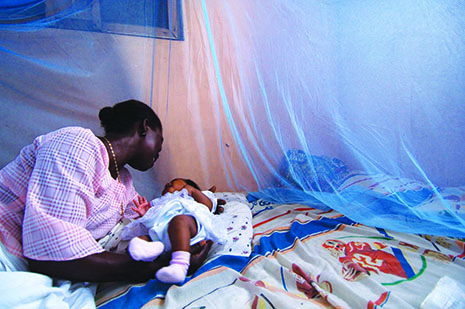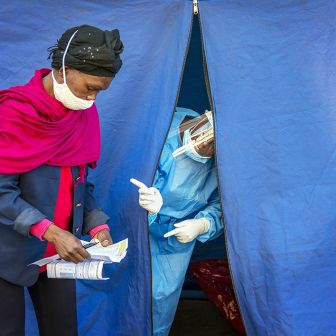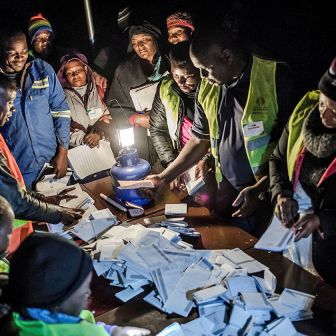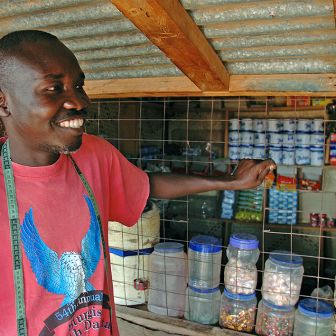I AM NOT a light traveller. Heading off on reporting trips in Africa I tend to take too many books and too many clothes. But one thing I never regret having with me as I lug my bag across the tarmac or struggle to strap it on the back of a motorbike taxi, is my bulky medical kit. For it contains not just the usuals – headache tablets, Imodium, plasters – but also the things that prevent a tiny buzzing insect from disrupting my sleep and threatening my life: a mosquito net, mosquito repellent, a malaria testing kit and a course of treatment.
For foreign reporters and holidaymakers from the West, the cost of these items is quickly forgotten. But in Africa’s malaria zones, a net alone has long been a luxury many households could not afford. As a result, the disease has been Africa’s biggest killer. In 2000, for example, some 900,000 people on the continent died after being bitten by the anopheles mosquito. (The total for the rest of the world, according to the same World Health Organization figures, was only 85,000.)
But now, thanks to a massive increase in spending on malaria control over the past few years, the disease appears to be in retreat. The WHO’s latest malaria report estimates that fatalities in Africa in 2009 fell to 709,000 – a 21 per cent decrease – despite a significant increase in the population over the same period. (Outside Africa, deaths fell 15 per cent to 72,000, most of them in Southeast Asia.) The results were “the best seen in decades,” WHO director-general Margaret Chan said when the report was released.
In those African countries that benefited from “intense malaria control inventions” – generally smaller nations, where the logistics are less challenging – the progress was even more startling. In eleven African states, including Algeria, Botswana, Cape Verde, Eritrea, Madagascar, Namibia, Rwanda, São Tomé and Príncipe, South Africa, Swaziland and Zambia, the number of malaria cases or hospital admissions and deaths fell by more than 50 per cent.
Two main malaria control methods are behind the success. The first involves spraying insecticide on surfaces inside houses on which the anopheles mosquitoes usually rest after, in medical-speak, they’ve enjoyed a “blood meal.” Expanded spraying programs meant that by 2009 seventy-five million people in Africa, roughly 10 per cent of the population at risk, were protected. This is an almost sixfold increase since 2005, when spraying programs covered just thirteen million people.
But the largest gains can be attributed to something even simpler. “The roll out of insecticide-treated nets is responsible for the greatest progress,” Richard Cibulskis, the coordinator of the strategy, economics and elimination team in the WHO’s malaria program, told me by phone from the Philippines, where he was on a work trip. “Most malaria in Africa is transmitted between ten o’clock a night and four in the morning,” he said. “And mosquitoes don’t like nets.”
By the start of the year, 289 million mosquito nets had been delivered to sub-Saharan Africa, enough to cover three out of every four people at risk of malaria. More than 40 per cent of households owned at least one net, and 35 per cent of children slept under one. This is still far below the WHO’s target of 80 per cent of children: access to nets remains low in some of the biggest countries, where poor infrastructure, poor governance or, in some cases, conflict have made it difficult to work. In 2008, fewer than 10 per cent of households in Democratic Republic of Congo and Nigeria owned a treated net, for example.
But in those nations where large-scale net distribution programs have been possible, their effectiveness is clear. In Eritrea, the tiny Red Sea state whose repressive government usually makes news for the wrong reasons, more than a million nets were distributed from 2000 to 2006, covering 80 per cent of households in high-risk areas. A further 564,000 long-lasting nets were issued between 2007 and 2009, and spraying and treatment programs were also stepped up. As a result, the number of malaria cases dropped from 126,000 in 2001 to just 22,000 in 2009 – an 83 per cent decrease. Deaths fell by the same percentage.
In neighbouring Ethiopia, where the logistical challenges of distributing nets are far greater, there was also good progress. Between 2005 and 2009, twenty-five million treated nets were delivered. Hospital admissions and deaths dropped by 50 per cent compared to 2004. On the tropical Tanzanian island of Zanzibar, home to 1.3 million people, enough nets have been issued in recent years to cover the entire population. Nearly all households have also been part of insecticide spraying programs since 2006. While non-malaria hospital admissions on the island increased from about 14,000 to 18,000 per year over the past decade, malaria admissions have dropped from around 10,000 to 2000. Annual deaths from the disease fell from nearly 350 to around twenty over the same period, a fall of more than 80 per cent.
Treatment has also improved, with the preferred artemisinin-based combination therapies now far more widely available in public hospitals in Africa than a few years ago. Nineteen countries have sufficient stocks to cover between 50 and 100 per cent of all malaria cases.
But while the overall gains are impressive, the World Health Organization has warned that they are fragile. The first problem is financial; funding for malaria control increased dramatically in recent years but stagnated in 2010 at US$1.8 billion, far short of the US$6 billion that the WHO says is needed. The other issues are practical, starting with the bed nets. Most of the nets only last three years, and must then be replaced. If not, there could be “a resurgence in malaria cases and deaths,” according to the WHO.
“Often replacement is more difficult than roll-out – there’s not the same energy involved,” says Cibulskis. “It’s a big challenge and we’re still learning how to do it.”
The insecticides used for spraying, and on the nets themselves, come from a single class – pyrethroids. This increases the risk that mosquitoes will develop resistance. The continued use of existing artemisinin-based monotherapies – rather than the recommended combination treatment – also threatens the life of combination therapies by fostering resistance to artemisinins.
There also needs to be a greater knowledge of what works and what doesn’t. In 2009, for example, Rwanda, São Tomé and Príncipe and Zambia, which had all seen big gains in malaria control, experienced modest rises in the number of cases, for reasons “not known with certainty,” reports the WHO.
But Cibulskis is still optimistic. “There remains a huge opportunity for us to understand the epidemic of malaria better – where it strikes, which age groups, what works best,” he says. “That way we can target resources more efficiently.” •




